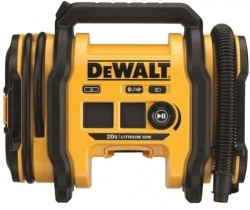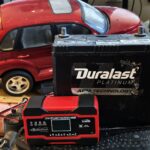Portable air compressors for cars have become indispensable tools for vehicle owners. From inflating tires on the go to powering air tools for roadside repairs, these devices offer convenience and reliability. If you’re considering adding a portable air compressor to your car emergency kit, understanding their capabilities and limitations is crucial. This guide will explore what you need to know about portable air compressors, particularly when dealing with larger tires and demanding inflation needs.
Understanding the Limitations of Portable Tire Inflators
One common question among car owners, especially those with larger vehicles or off-road tires, revolves around the limitations of portable air compressors. Many users are drawn to the convenience of compact, cordless inflators like the Dewalt DCC020IB, praised for features like preset pressure settings and automatic shut-off.
However, concerns arise regarding their ability to handle larger tire sizes. While a compressor might boast a high PSI rating, such as the Dewalt’s 160 PSI, the real-world limitation often lies in the flow rate. For instance, inflating a large 35-inch tire, commonly used in off-roading, to 45-50 PSI might take a considerable amount of time with a lower flow rate compressor. This is where understanding the specifications beyond just maximum PSI becomes important.
Real-World Tire Inflation Needs and Solutions
Many drivers face the dilemma of balancing convenience with performance. Imagine the scenario of off-roading: deflating tires for better traction on trails and then needing to reinflate them for highway driving. Using a slow portable inflator can turn a quick stop into a lengthy chore, potentially deterring drivers from optimizing their tire pressure for different terrains. Some might even choose to endure a less comfortable ride rather than deal with slow inflation times.
For those who frequently adjust tire pressures or own vehicles with larger tires, relying solely on basic portable inflators might prove insufficient. While convenient for topping off tire pressure, they might struggle with significant inflation tasks. This leads to exploring alternative solutions for faster and more robust tire inflation.
Exploring Alternatives for Demanding Inflation Scenarios
When portable electric inflators fall short, especially for frequent off-roaders or those needing rapid inflation, other options come into play. One such alternative is a CO2 tank system, often referred to as a “power tank.” These systems offer rapid inflation, significantly faster than most portable compressors.
However, CO2 tanks also come with their own set of considerations. The inconvenience of needing to refill the tank is a significant drawback compared to the readily available power source for electric compressors. Another high-performance option is investing in a premium onboard air compressor system, like those from ARB. ARB compressors are known for their reliability and high output, capable of handling large tires and frequent use. However, the higher cost associated with ARB systems can be a barrier for some users.
Finding the Right Balance for Your Needs
Choosing the right portable air compressor for your car involves assessing your specific needs and usage patterns. For occasional top-offs and standard tire sizes, a compact cordless inflator like the Dewalt DCC020IB can be a great choice, offering convenience and ease of use. However, for larger tires, frequent inflation adjustments, or demanding scenarios like off-roading, considering higher-flow portable compressors, CO2 tanks, or onboard systems might be necessary. By understanding the limitations and exploring the alternatives, you can make an informed decision and ensure you’re well-equipped for all your tire inflation needs.



